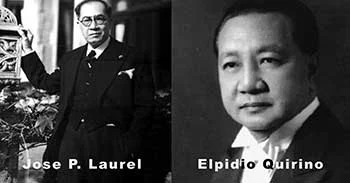A CIA Report’s View on Elpidio Quirino’s Presidency and the Continuing Influence of Batangas’ Jose P. Laurel
[In this page: Elpidio Quirino, Jose P. Laurel, 1949 Philippine Elections, Nacionalista Party, Liberal Party, fraudulent election 1949, declassified CIA report]
Readers will recall from high school History books that the Ilocano Elpidio Quirino was elected as the 6th President of the Philippines1 and 2nd after Manuel Roxas of the so-called Third Philippine Republic. Having assumed the presidency due to the untimely demise of Manuel Roxas in 1948, he would defeat Batangas’ Dr. Jose P. Laurel the following year in what some accounts called “the dirtiest elections” in Philippine History up to that point.
From a declassified Central Intelligence Agency (CIA) document2 dated August 1950, we are able to gain insights about how the American intelligence community viewed Quirino’s presidency. Likewise, we get some insights about how the same community regarded Laurel’s role in Philippine politics.
 |
| Dr. Jose P. Laurel of Batangas (left) and President Elpidio Quirino. Both photos in the public domain. |
“Ineffective Philippine leadership in the face of markedly increased domestic instability provides the opportunity for opposition elements, under the leadership of Vice-President Lopez3, to restrict or eliminate President Quirino’s authority prior to 1953 [Note: a reference to the national elections scheduled in 1953]. Although failing health may bring about Quirino’s retirement at any time, political pressures continue which may relieve him from authority by: (1) the device of a ‘long vacation;’ (2) a gradual delegation of power to Vice-President Lopez; (3) forced resignation; or (4) if these means fail, impeachment. Assassination or a coup d’etat, although unlikely, cannot be ruled out entirely.”
It may interest the reader to know that this was a time when the Philippines still modeled its party system after the United States’, which up to the present has a bi-party system with the two major groups being the Republicans (conservatives) and Democrats (liberals). In the Philippines, the two parties were the Nacionalistas (conservative) and the Liberals.
It may further interest the reader to know that the aforementioned Vice-President Lopez was, in fact, at the time like Quirino a member of the Liberal Party. In other words, the political distress was, in fact, emanating from the same party. Why Lopez would want to become the primary opposition to Quirino, supposed to be the moral leader of his own party, the CIA document tried to conjecture:
“Political opposition to the government aims at the removal of Quirino personally, or the general reform of the administration. Vice-President Lopez, partly because he desires to play a more important role in the administration than Quirino will grant him, partly because he wishes to protect his own and other extensive business interests by assuring a competent and stable government, and partly because he evidently has a feeling of responsibility for the public welfare, leads those who seek Quirino’s removal from power.”
“The Nacionalistas, led by Jose Laurel, a demagogue who collaborated with the Japanese, have always opposed Quirino.”
Further discussion on whether Laurel was a collaborator or not is available in this article: Was Dr. Jose P. Laurel, Batangueño President of the 2nd Philippine Republic, a Traitor?
“All these opposition elements blame the President personally for Governmental corruption and inefficiency, worsening financial problems and the November 1949 election scandals. Their tactics take the form of press attacks, refusal to serve in public office, exposure of Government graft and the rejection of administration-sponsored legislation.”
“Jose Laurel, spokesman for the Nacionalista Party, has temporarily retired from politics and has recently been reported as giving covert backing to Vice-President Lopez. Laurel is still very popular and, despite his retirement, could quickly rally considerable popular report. While Laurel would probably not organize a ‘reform’ movement of his own, he might attempt to capture the leadership of any such group.”
To conclude, the primary concern of the CIA report was to assess the stability of the Philippine government and particularly so in the face of the growing reach of communist ideology, embodied in the country by the Hukbalahap Movement. Said the report: “…the accomplishment of some real reforms, followed by reasonably honest elections in 1953, would insure continuance of a non-communist pro-US regime.”
Laurel would, in fact, be overwhelmingly elected to the Senate in 1951. But Quirino was, in fact, not done just yet. Despite failing health, he ran for a second term in 1953. The writing was, however, on the wall as early as 1951 when no member of the Liberal Party was elected to the Senate. It was likely no surprise one Ramon Magsaysay, erstwhile Secretary of National Defense, became the Philippines 7th President.
2 “Prospects for Stability in the Philippines,” published 10 August 1950 by the United States Central Intelligence Agency, online at the United States National Archives.
3 This was Vice-President “Fernando Lopez” of Iloilo. Wikipedia.
